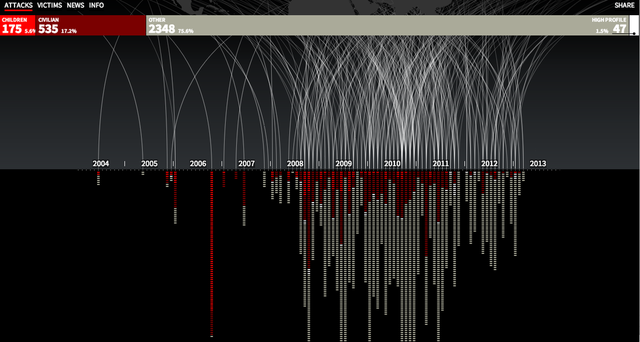 |
| Rug of Drones, Installation by Abdullan M.I. Syed |
Finding a way to organize politically against the covert and illegal terrorist drone attacks seems impossible, but there are many glimmers of hope over the last year. First, there is a growing
national anti-drone network and
the recent CODEPINK No Drone Summit, in the US, but more interesting are recent events in Pakistan. The Washington Post is reporting today that
Pakistan political parties are "outing" high ranking CIA officials as a form of protest against drone attacks and a Pakistani cricket-star-turned-political-leader
has organized protest blockades of NATO supply lines that are attracting thousands of Pakistanis.
The protestors maintain that drone attacks violate Pakistani sovereignty and are only deepening anti-American sentiment and strengthening the Taliban.
Malala Yousafzai agrees and last month used her audience with President Obama to tell him that
"drone attacks are fueling terrorism." and suggests that support for education for young Pakistanis might do a lot more to stop anti-American violence. The brave young anti-taliban activist elaborates in an interview
here. Despite the Malala's pleas, Washington still doesn't seem to be listening. Incredibly, only 5 members of congress showed up to hear the stirring
first hand testimony of this Pakistani family.
Artists are also protesting.
AlJazeera recently profiled
a new generation of Pakistani artists who are creatively expressing the
effects of violence and drone attacks on the fabric of their culture. And Mother Jones interviewed another Pakistani artist, Mahwish Chishty,
who re-imagined drones as folk art.
The anti-drone art movement in Pakistan is echoed in the West.
An exhibit this past summer at the Corcoran Gallery in Washington DC (a stone's throw from the White House) by James Brindle attempted to expose an American audience to the feeling of being overshadowed by drones, or at least to make the normally unseen seen. Brindle sees himself as an activist and said "“I’m concerned about the state of the world. There’s no illusions that
words and politics and speeches about clean wars and minimizing
collateral damages is anything but hot air,” See his interview with the BBC
here. Brindle also maintains the
"Dronestagram" Instagram feed of google earth images of drone-bombed sites.
 |
| James Brindle's installation, "Drone Shadow" Istanbul 2012 |
Instagram seems friendlier to drone activism than Apple. The "Drone +" iphone app which sends push notifications when a drone strike occurs has been
rejected by Apple three times because it "contained content that many audiences would find objectionable." Creator Josh Begley still maintains the popular twitter account
@dronestream tweeting every drone strike and its body count. Twitter is also home to the
US Drone War Department, a more satirical take on the drone war. A more graphic representation of the drone body count can be seen
here, just in case you have friends that need convincing of exactly how dramatically the Obama administration has ramped up this particular form of terrorism.











